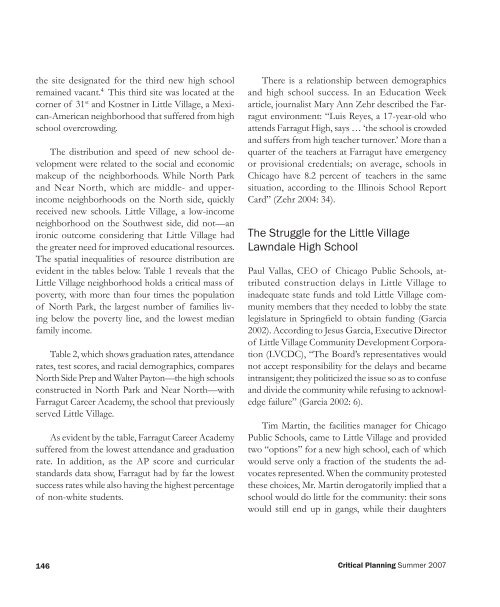158 Critical Planning Summer 2006 Critical Planning Summer 2007 ...
158 Critical Planning Summer 2006 Critical Planning Summer 2007 ...
158 Critical Planning Summer 2006 Critical Planning Summer 2007 ...
You also want an ePaper? Increase the reach of your titles
YUMPU automatically turns print PDFs into web optimized ePapers that Google loves.
the site designated for the third new high schoolremained vacant. 4 This third site was located at thecorner of 31 st and Kostner in Little Village, a Mexican-Americanneighborhood that suffered from highschool overcrowding.The distribution and speed of new school developmentwere related to the social and economicmakeup of the neighborhoods. While North Parkand Near North, which are middle- and upperincomeneighborhoods on the North side, quicklyreceived new schools. Little Village, a low-incomeneighborhood on the Southwest side, did not—anironic outcome considering that Little Village hadthe greater need for improved educational resources.The spatial inequalities of resource distribution areevident in the tables below. Table 1 reveals that theLittle Village neighborhood holds a critical mass ofpoverty, with more than four times the populationof North Park, the largest number of families livingbelow the poverty line, and the lowest medianfamily income.Table 2, which shows graduation rates, attendancerates, test scores, and racial demographics, comparesNorth Side Prep and Walter Payton—the high schoolsconstructed in North Park and Near North—withFarragut Career Academy, the school that previouslyserved Little Village.As evident by the table, Farragut Career Academysuffered from the lowest attendance and graduationrate. In addition, as the AP score and curricularstandards data show, Farragut had by far the lowestsuccess rates while also having the highest percentageof non-white students.There is a relationship between demographicsand high school success. In an Education Weekarticle, journalist Mary Ann Zehr described the Farragutenvironment: “Luis Reyes, a 17-year-old whoattends Farragut High, says … ‘the school is crowdedand suffers from high teacher turnover.’ More than aquarter of the teachers at Farragut have emergencyor provisional credentials; on average, schools inChicago have 8.2 percent of teachers in the samesituation, according to the Illinois School ReportCard” (Zehr 2004: 34).The Struggle for the Little VillageLawndale High SchoolPaul Vallas, CEO of Chicago Public Schools, attributedconstruction delays in Little Village toinadequate state funds and told Little Village communitymembers that they needed to lobby the statelegislature in Springfield to obtain funding (Garcia2002). According to Jesus Garcia, Executive Directorof Little Village Community Development Corporation(LVCDC), “The Board’s representatives wouldnot accept responsibility for the delays and becameintransigent; they politicized the issue so as to confuseand divide the community while refusing to acknowledgefailure” (Garcia 2002: 6).Tim Martin, the facilities manager for ChicagoPublic Schools, came to Little Village and providedtwo “options” for a new high school, each of whichwould serve only a fraction of the students the advocatesrepresented. When the community protestedthese choices, Mr. Martin derogatorily implied that aschool would do little for the community: their sonswould still end up in gangs, while their daughters146<strong>Critical</strong> <strong>Planning</strong> <strong>Summer</strong> <strong>2006</strong> <strong>2007</strong>


